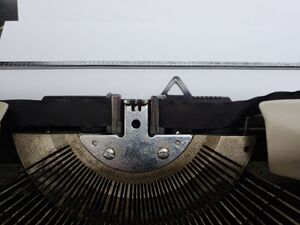Difference between revisions of "Kong Byung-Woo Typewriter"
m |
|||
| Line 3: | Line 3: | ||
== Basic Info == | == Basic Info == | ||
| − | + | [[File:Dual Type Guide.jpeg|thumb]] | |
| − | Meanwhile, the left type guide is used for 'final consonant', to align them up with consonant and vowel | + | Typewriters of this type have two type guides, while most of the other have only one. Among with the two guides arranged side by side, typebars for consonant, vowel, and some symbols are aligned for the right one. Their keys also moves the cursor forward, so syllables composed with consonant and vowel occupy two units of the character width. |
| + | |||
| + | Meanwhile, the left type guide is only used for 'final consonant', to align them up with consonant and vowel already printed and sent to the left. The keys for final consonants don't move the cursor forward, resulting in the complete syllables with consonant, vowel, and final consonant still occupying tow units of width. | ||
== History == | == History == | ||
Revision as of 05:13, 31 May 2022
The Kong Byung-Woo Typewriter, also known as 3-Set Hangul Typewriter, is the first of Hangul Typewriters to implement Syllable-based Hangul writing system along with LTR Horizontal writing.
Basic Info
Typewriters of this type have two type guides, while most of the other have only one. Among with the two guides arranged side by side, typebars for consonant, vowel, and some symbols are aligned for the right one. Their keys also moves the cursor forward, so syllables composed with consonant and vowel occupy two units of the character width.
Meanwhile, the left type guide is only used for 'final consonant', to align them up with consonant and vowel already printed and sent to the left. The keys for final consonants don't move the cursor forward, resulting in the complete syllables with consonant, vowel, and final consonant still occupying tow units of width.
